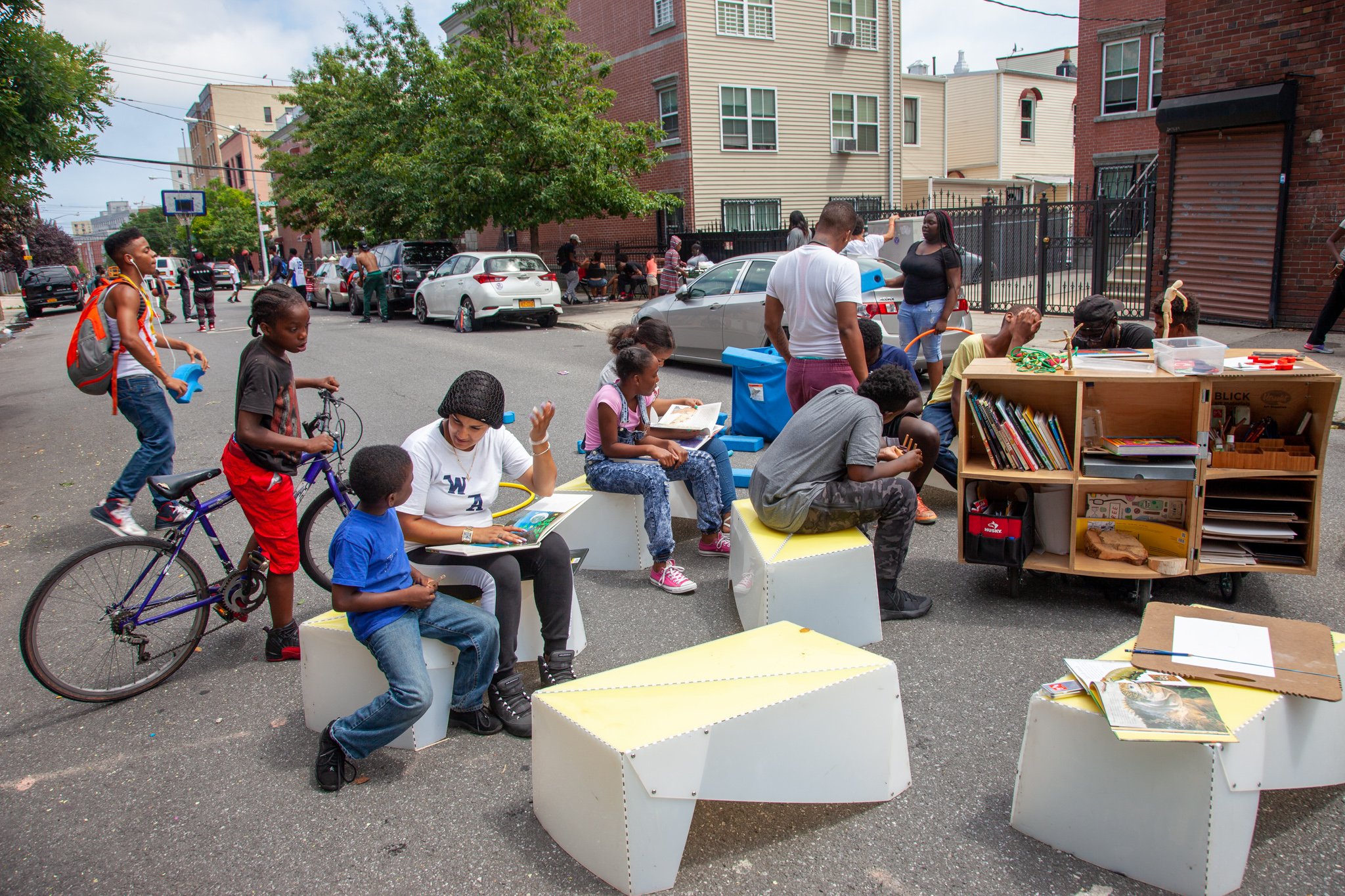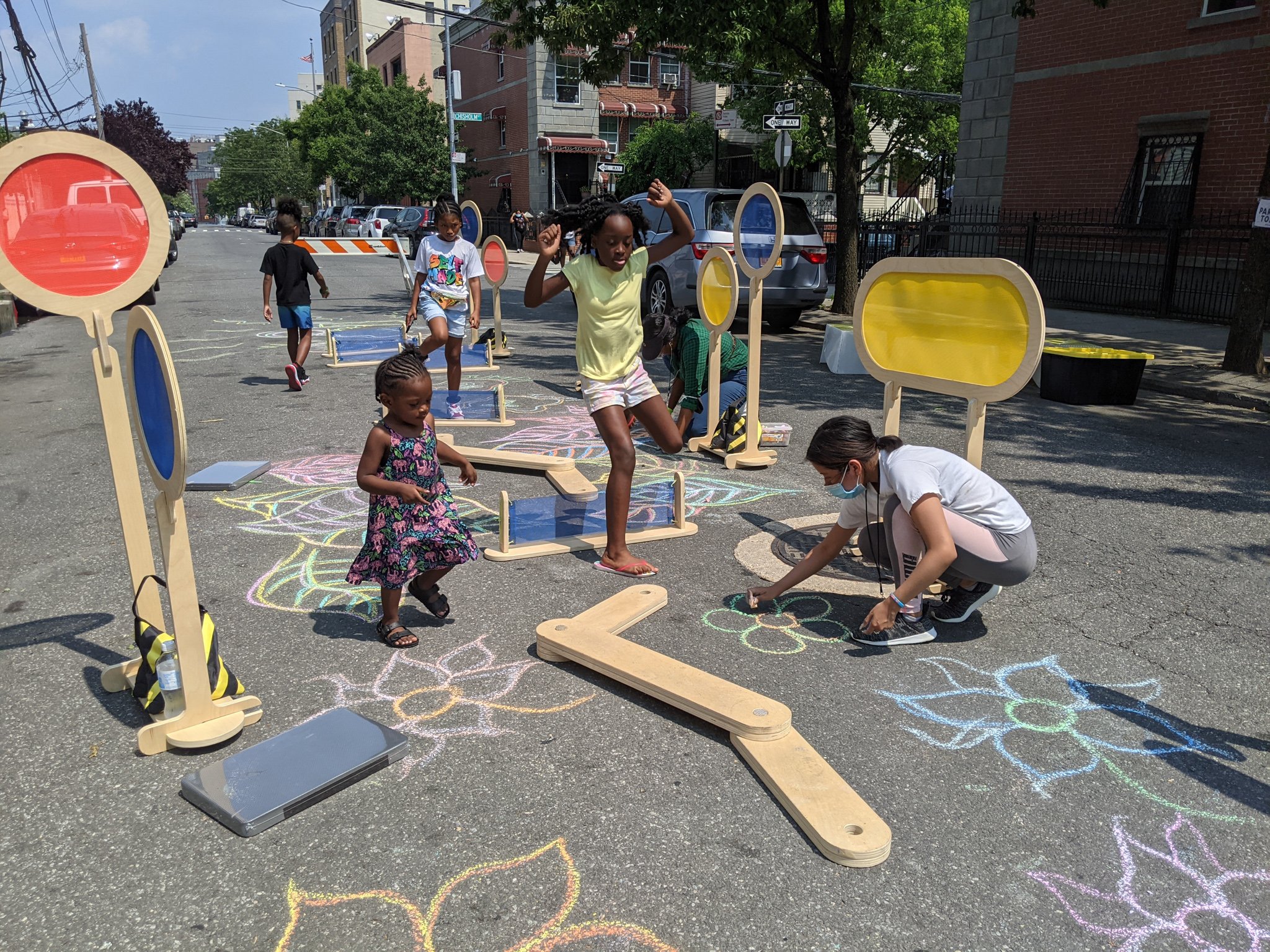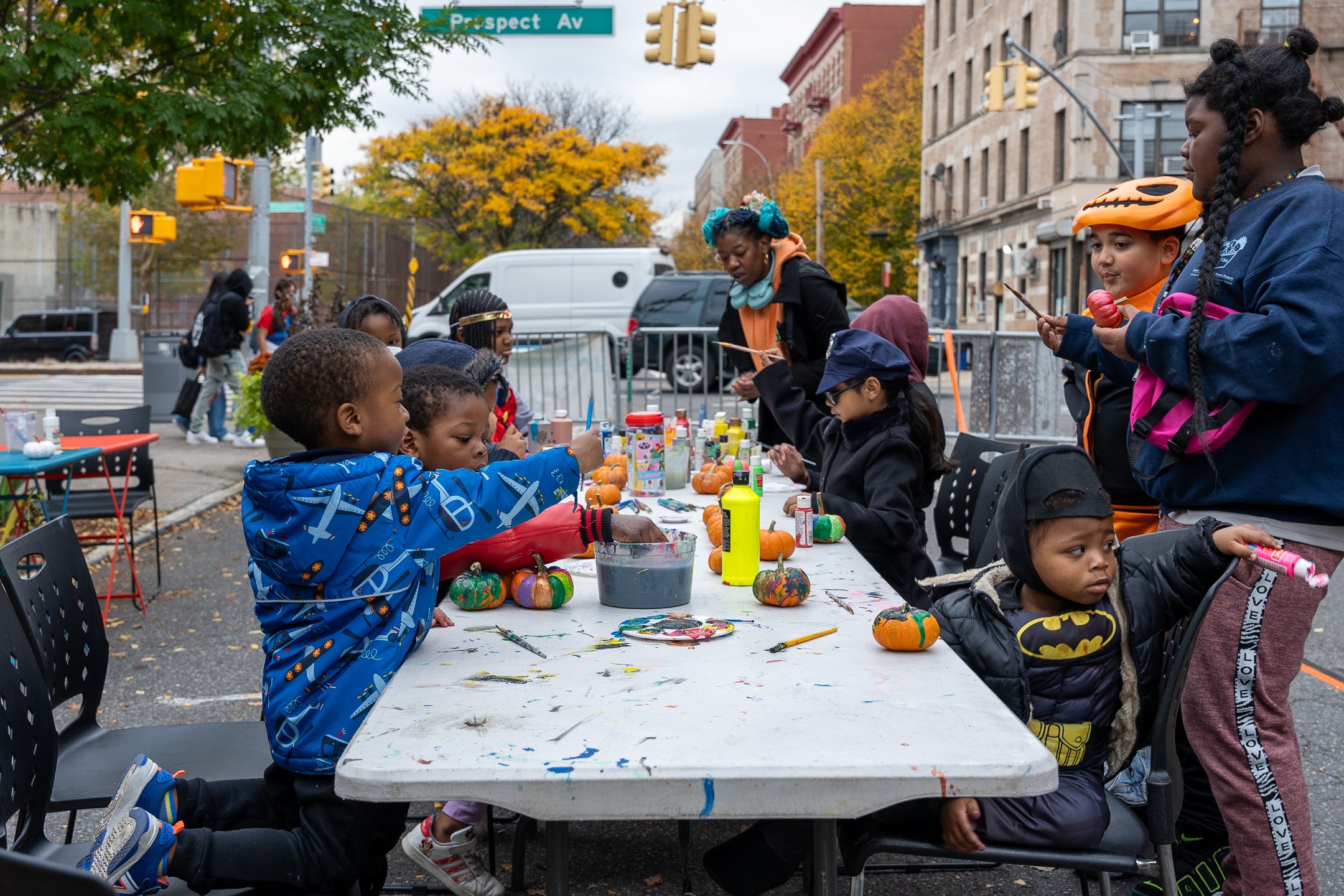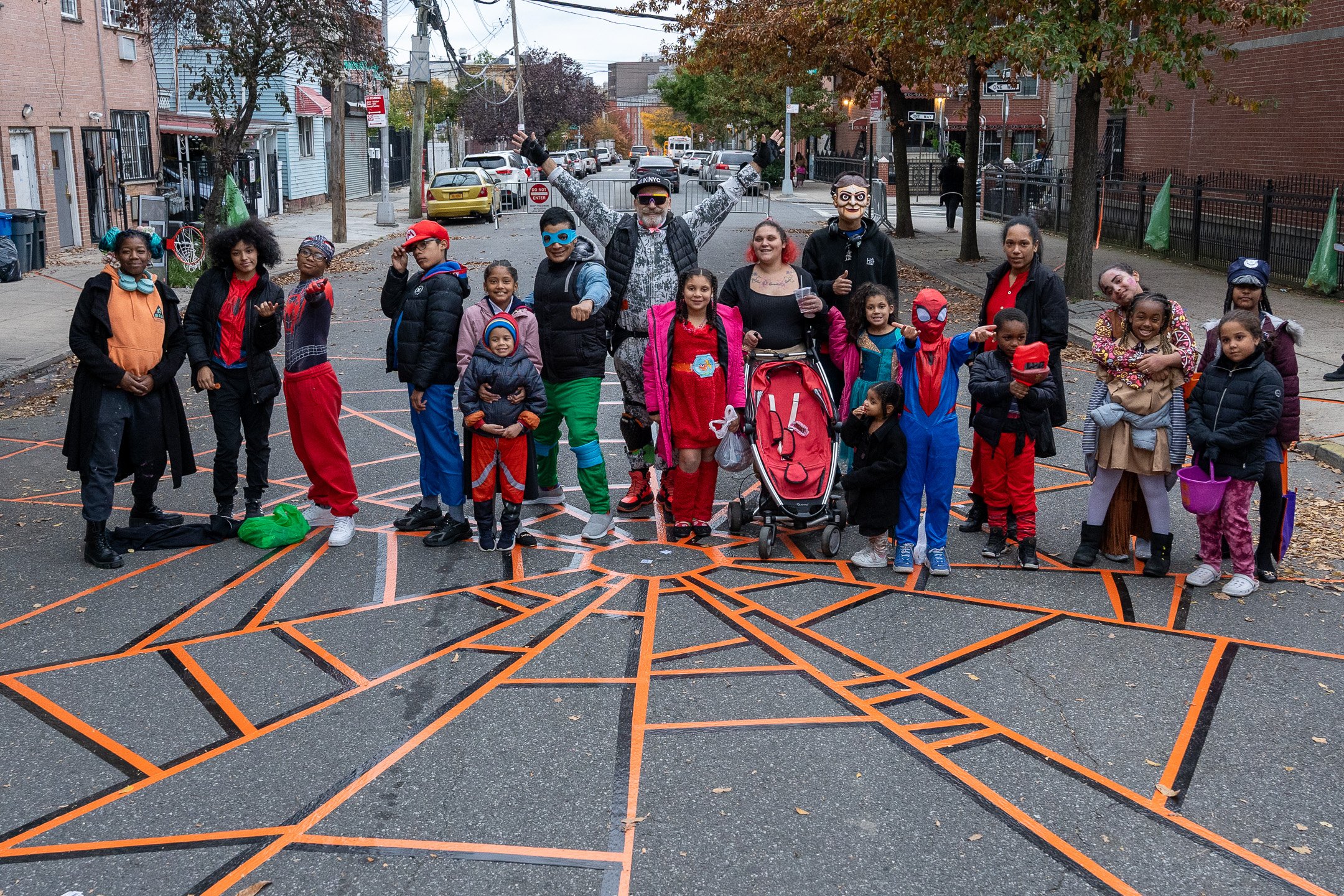Borough President Vanessa Gibson wants to reduce car culture in the Bronx
What does Vanessa Gibson envision for the future of Bronx streets? What motivates her to make the borough a more people-centered space? Join Open Plans’ Jackson Chabot for this al fresco conversation with the Bronx BP and Lonnie Hardy, a Bronx activist, director at the Caldwell Enrichment Program and manager of the Jennings Open Street.
They touch on why car-free streets can help rectify the impact of years of City neglect and disinvestment in the Bronx, why abundant and flexible public space is so important for communities, and which NYC spots are the BP’s favorites (spoiler — they’re all in the Bronx!).
Open Plans’ Jackson Chabot: Good afternoon, everyone. We're here with Bronx Borough President Vanessa Gibson. We're here on Jennings Open Street in the Bronx. And welcome. Thanks for coming out this afternoon.
Bronx Borough President Vanessa Gibson: Thank you for having me today.
Open Plans: So like I said, we're on the Jennings Open Street here. We've got kids in the background playing basketball, jumping rope. What's your first impression?
BP Vanessa Gibson: It's beautiful. It's a gorgeous day. We have great weather on our side. And it's really a chance to bring our young people together, to recreate, to have a safe space for activities. Whether it's jumping rope, playing chess, playing spades or board games or basketball. It's a chance to also advance health and wellness among our young people because we have high rates of asthma and obesity among children in the Bronx. And I think when you look at open spaces, it's a chance to have an opportunity to activate and really make sure you change the landscape of our Open Streets, which we all know are streets without drivers and cars and trying to reduce the carbon footprint and really open up our streets for more pedestrian and children friendly activities.
Open Plans: It's true you say that the kids are out here, they're together, they're building community. And it's a really beautiful weather afternoon but it's also a beautiful experience. And so, you know, when you see this, how can we do more of this across the borough?
BP Vanessa Gibson: So I think it's important to always work with incredible messengers on the ground like Ms. Lonnie and the Caldwell Enrichment Program. They are a non-profit, an incredible messenger and a trusted partner that are already doing this work. And a lot of times they don't get the recognition, they don't get the million dollar contracts from the city. And that's important. You need resources, you need programs, you need equipment. You know, closing the street is one thing, but what you put on that street is equally as important from the basketball courts, the board games, you know, chess and everything that we know we obviously need in an Open Street.
So I think it's about getting the government to recognize the importance of it and investing with real resources and money. And I also think it's about getting many of our other neighborhood partners, like health care institutions, our school community, our faith communities, our other CBOs [Community Based Organizations], and so many others that have resources. They have the audience, they have the constituency, and they have the reach. And that's what we want. We want to expand our reach because neighborhoods like this need so much. And when you serve one, you serve all and by word of mouth, by talking to each other, going to the same school within the same school district, they have a conversation about what's available. And that's how you get more kids and you expand your reach.
Open Plans: Yeah, that's a great point. Even, you know, before you showed up, Ms. Lonnie and I were talking about some of the mosques in the neighborhood and how they're interested in space like this, which is, you know, a tremendous opportunity because there's also schools associated with the mosque. So like you're saying, it becomes this layering effect. And of course, as you're pointing out, people talk, which is great, sometimes not so good, but it can be good. And so, you know, we see schools, children here and correct me if I'm wrong, but there are several schools represented here. How many schools are represented, Ms. Lonnie?
Ms. Lonnie: We have five. But right at the moment, we have one school and one daycare.
Open Plans: And so, like you're pointing out, and there was another mother who was here before and she was saying she's going to go get her children from her school and come back because there's not much to do in the neighborhood. And to your point, this is a great resource and becomes something for them. And so what does it take or what does it look like to allocate those resources? I've talked with Ms. Lonnie, and that is one of the biggest challenges here.
BP Vanessa Gibson: Yeah. I think, you know, when you look at the Bronx, we are an outer borough that's often been denied and ignored and not given our fair share. And I think a lot of the city initiatives have been great. Open Streets, Summer Streets during this time and really led by DOT, the Department of Transportation, and this new administration under the leadership of Mayor Eric Adams. But I think we have to do more. A lot of the Open Streets and the concept of it really starts in Manhattan, right? We have to be very honest. And when you look at the outer boroughs, we don't always get that attention. And now you're seeing DOT have five-borough approaches. Even Staten Island is being recognized.
I remember growing up, we didn't have Open Streets, we had a block party. You had to get a permit. You had to make sure you remove cars because it was always this car culture that we're trying to get out of. And as a borough of opportunities that we represent here in the Bronx, it's a hard conversation to have because any time you close a street, there is a change in the traffic pattern. There's a disruption of the normalcy of traffic and the car culture. And of course, we want to be mindful and sympathetic to those who drive and older adults who have mobility issues. But I think we also want to be very sympathetic to prioritize children. And I also recognize children that have special needs, children that are in the D75 community, that are autistic, that need sensory equipment and special equipment so that they can be just like any other child. And sometimes that's not always recognized. And we're now starting to do that in our parks with sensory equipment. And that's important. I hear often from many parents of D75 scholars that struggle with accessing programs for their scholars and their children. And so that's important to me to raise. This work is always about a balance. I think when you put organizations, the business community, the BIDs, the merchants, as well as the CBOs, different organizations that are in our communities, and you have conversations involving the community board involving the elected officials, involving the agency. You can come up with ideas on Open Streets that I think everyone can truly support. But at the end of the day, no one wants you to disrupt their normal.
Open Plans: True. It is a difficult process.
BP Vanessa Gibson: It is a difficult process. But I also think too that one thing we all can agree on is that children need safe spaces and they need recreation in their lives. It's a part of the core of their academics, of their curriculum and the experience of learning. Developing your cognitive skills, of building sportsmanship, and teamwork so that young people would know how to work together. Yes, we all have our little competitive component, but young people know how to be competitive in a good way and still work together. And I'm on a team. And like the young man said, it's a place where people care, right? They look out for you, You feel safe. And it's the neighborhood feel and the neighborhood approach that makes these programs so successful.
Open Plans: I agree. And I love when you talk about creativity. And I think, you know, in the absence of resources, creativity is needed. We were talking with Raymond, who lives here. He's lived in the building here for 20 years, I found out, and Ms. Lonnie was telling me on a hot day and a hot set of weeks, he'll come down here and water the plants and it takes that type of collective effort you're also describing. And so, you know, it takes the resources, but it also takes the creativity and the teamwork as well.
BP Vanessa Gibson: And I always say to many of our residents, you don't need a title in front of your name to care about your community. And you need to realize that we're all in this together. And if we work together, we really are a powerful force. We are unstoppable. And many of our community leaders started somewhere. They started as a volunteer and an intern and they grew.
Open Plans: Where did you start?
BP Vanessa Gibson: I started as an intern with the late great Aurelia Greene. I got an opportunity to work for her when she was in the assembly and moved on to become the deputy Bronx Borough President. And so internships are great. I love the fact that this program incorporates summer youth. Yeah, because summer is the time when so many school children are out of school and they're idle, and we need them to be positively engaged and it also builds skills. It builds your resume, in terms of volunteer experience, adding more things to your resume so that you can go to college and careers and real pathways. And all of this is so important for our school children. It's so important, I see the vision, I see the promise and I see the potential. And I ask everyone in our communities, get involved. You can adopt your block. You can plant trees. The Parks Department will give you materials for free if only you reach out. Everyone is not going to come to you because they don't necessarily know who you are and they don't always know where the need is.
But if people are willing to reach out, for example, Community Board 3, the District Manager here is Ms. Etta Ritter, they are right here on Boston Road. If you call Ms. Etta and say “Hey, we need cleaning tools for a clean-up event.” Picking up garbage. I mean, things like that matter. The quality of life, what they matter, right? If the garbage is overflowing when you're poor and you have to step over a mattress that's on the corner, that's not acceptable. And then that doesn't speak to what it means when we talk about the quality of our neighborhoods. And it can be addressed. And it's not just you know, people say that certain neighborhoods get more attention than others. I think there were people that care more than others sometimes. And it doesn't mean that things are less important. It means that people have a lot of priorities. And I get it. The communities that we represent, people are struggling for basic necessities. They're living below the federal poverty level. They're working two or three jobs to take care of the kids. And so everything is about the next thing. I got to get to school, I got to get to work, I got to pick up my kids. I've got to go home. I got to get homework done. I have to cook. And it's just day to day, right? It gets monotonous. And that's the normalcy. But I also think that where people can, we should have that avenue for them to volunteer. PTA parent coordinators, community board meetings, precinct councils like the 42nd Precinct. And we have a lot going on here and we can also be involved with our NYPD. There's a lot of volunteer opportunities and I just ask everyone to engage, find out about what's going on in your community and ways that you can help.
Open Plans: Well, I know Ms. Lonnie would always take more volunteers, so that's an easy plug here locally. And, you know, I appreciate how you're talking about that being involved perspective. And one of the things we were discussing before you got here was around how this feels like a community center. Obviously, we're outside, so it’s a mix of like a block party. But, you know, in that sense that we're here and people are coming by as they go to the store, they come back, they're biking by, they're saying hello. They're not necessarily staying here for 5 hours like they would be at the library, but they're coming and going. And so it has that very approachable feel to it. So it's like the neighborhood is baked into it. And I think that's, you know, critical to what you're saying about the credible messengers as well. So I'm curious, if you were to design a space like this, you know, you see all the things, we can have more plants, we could have more trees. What would you put?
BP Vanessa Gibson: So first, I want to make sure all the cars are gone. Number one.
Open Plans: And why is that important?
BP Vanessa Gibson: Because I think it's an attempt to reduce the car culture. And people, knowing that this is an Open Streets, on a particular day need to move the car. And we put signage up days in advance. And people either don't look or don't think it's important and don’t move their car. And, you know, we have to have a behavior that's better. We have to change the behavior so that everyone is involved in this and everyone realizes the importance of it. And then number two, I want to make sure that Open Streets have a variety of programs, and that's where the city comes in. Yeah. So we've had, you know, Open streets over the summer. We have organizations like the Fresh Air Fund, Bronx Works, Catholic Charities, so many of our cornerstones and our SONYC and Compass programs, and summer camps. I know them all because many of them are funded in the City Council.
Open Plans: Totally. You got the laundry list.
BP Vanessa Gibson: Yes. Bringing in basketball. I love karate. I learned about squash. Squash ball. Which is a form of racquetball. And there's an organization called City Squash that's building a new squash recreation center in Belmont. And it's going to be a community center, but it's going to have that entire. And I'm like, okay, the American version is for racquetball. I funded an organization called U.S. Wall Ball Association, and Wall Ball is the European version of HandBall. So I'm like, Oh, that's handball. Okay. So they call it Wall Ball. I love handball and I love to renovate our handball courts. I like variety. I think sometimes when I see developers and others that are coming into the borough, they just assume that children of color only play basketball and baseball and it's annoying that they assume that.
And I funded chess in schools. I funded lacrosse and fencing and karate and volleyball. And these are all different sports that you don't always see students of color. You don't see young girls and women. And boxing. So we're looking at all of this. Who are our boxing centers? How can we incorporate many of those programs, obviously, into our schools? But if we can do it in an open street setting, we should look to do that as well.
Open Plans: That's great. Okay, your favorite public space in the borough?
BP Vanessa Gibson: Oh, I have a couple. One of my favorite spaces is the High Bridge, the oldest standing walking bridge in New York City. And we recently reopened it under Mayor Michael Bloomberg. It's gorgeous and lights up at night. It's 1400 steps from the Bronx to northern Manhattan. I love the high bridge. I work. Of course, I have to recognize it, I call it our Central Park of the Bronx. It's our very own state park, Roberto Clemente State Park. There you go. Named in honor of Roberto Clemente. Amazing. 50th anniversary this year, 58, 1973. Roberto Clemente State Park. It's huge. I mean, Tour de Bronx. I almost got lost in Pelham Bay Park. I love Pelham Bay because it's the largest park. It allows the Bronx to be the greenest burrow in the city of New York. It's true. I love Orchard Beach because we have 6 million visitors that come every year and we are transforming the pavilion. All of our parks and playgrounds I absolutely love. I really like the playgrounds. But some of the newer renovated parks, the reason why I like them, I like the only example I could think of is Cedar Park, which is in Morris Heights. Near Roberto Clemente. Okay. Because when we redesigned it, we have equipment for children, we have playground equipment, we have basketball, and we have fitness equipment. For people to exercise. And that's the new concept of parks. So you cater to the younger, the teenagers and everyone else that wants to work out. And I think that's amazing. We have such beautiful historic districts in the Bronx. When I think about neighborhoods that have been transformed. So I have lots of parks, lots of playgrounds that I just think are so beautiful and iconic for the borough and talking about it and making sure that people visit.
And I guess I also want to add, we have beautiful cultural institutions. Everyone visits the Bronx Zoo. The New York Botanical Garden. Wave Hill in Riverdale is beautiful. The Pregones theater, which is the Puerto Rican traveling Theater on Walton Avenue is amazing. We have organizations like Ghetto Film School that are training young people to be film producers. How amazing is that?
We have such history in this borough. I could tell you about the Bronx River Art Center. The Bronx River Alliance. Rocking the boat. I've known Adam Green for years when he used to be in the Harlem River and now he is by the Bronx River. What we've done with Starlight Park to transform that. The Sheridan Expressway and how we’ve transformed that. And that would be a great idea because it's such a big thoroughfare. We're building housing along both sides and just greater access to the Greenway. That's the importance. Like we never envision a time when we would have families living along the waterfront. And most recently I was with developers L&M and the city and HPD, and we cut the ribbon on phase one of Bronx Point, which is called the Lower Concourse. It's along the Harlem River exterior street by the 145th Street Bridge. And it expands Mill Pond Park by 2.9 acres. It's next to the Bronx Children's Museum, which is the first children's museum for us in the Bronx. And it creates 542 units of housing. And you get to live on the waterfront at an affordable rate.
Open Plans: Amazing. So we'll leave it there. I appreciate your time this afternoon. Thanks for coming. Anything else you want to add? Anything that we missed?
BP Vanessa Gibson: I guess the last question I would add is the future of what Open Streets look like. It means a recognition that there could be more that we're doing. There could be more to activate spaces, changing the car culture of our city. Yes, we know we need certain modes of transportation, and that's why we're adding four new Metro-North stations in the East Bronx. We want people to have choice. That's the biggest thing. We want people to have choice and alternatives. We want people to feel that all of these initiatives like Summer Streets, Open Streets, and what we're doing with restaurants, and permanent outdoor dining, is to add value to a neighborhood, not take away. Because some people feel like you take it away by parking, you take it away. There's “you're adding to my commute” and it's always negative. But I want people to think in the positive because the borough has been behind for so long. And I feel that we are on the cusp of a new renaissance. We are a borough of opportunities and a global destination. People come to the Bronx because they want to and I appreciate that and I want to make this borough the best to live, to work, to raise your family and to do business, because that's important. The economic growth and the viability of our borough is based on jobs and job creation and how we support small businesses. All of that is relative. But you have to have open space. Everything we do to me, has to have a health component because I think about obesity, diabetes, high blood pressure, heart disease, everything the Bronxites have been affected by, exacerbated by COVID. And now we're still dealing with that. And that's a reality. And we're seeing that among children more and more and more. And that's important for me. So when you think about Open Streets, you think about health and wellness, walking, jogging, bike riding, basketball, like, you know, exerting energy.
Open Plans: These kids were out here playing and they didn't even know they got exercise.
BP Vanessa Gibson: Yes, they did. Lots of exercise. So the future is bright. Stay tuned.
Open Plans: And the sun is shining on us.
BP Vanessa Gibson: The sun is shining. And we will continue to have further conversations about how we can expand Open Streets and really activate our spaces for all of our children, our families, our older adults. Don’t wanna ever take away from our older adults and our seniors and also our children and people with disabilities. We have to take care of them as well.
Open Plans: Yes. And I love how that theme throughout the conversation has been access and its access and options. And I think you're doing a great job with everything that you highlighted here. Ms. Lonnie is doing a great job with everything that she is leading here as well with access and opportunities for the youth. But like, you know, she preaches, like you just said, for everyone in between youth, seniors and everyone in between. So thank you so much for sharing.
BP Vanessa Gibson: Oh absolutely.
Open Plans: This is amazing. Yeah.
BP Vanessa Gibson: All right. Wonderful job.
Open Plans: That's a wrap.







